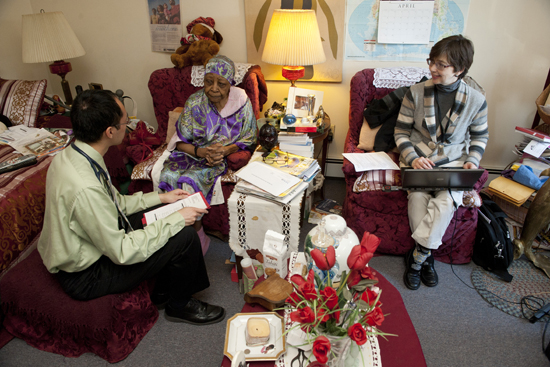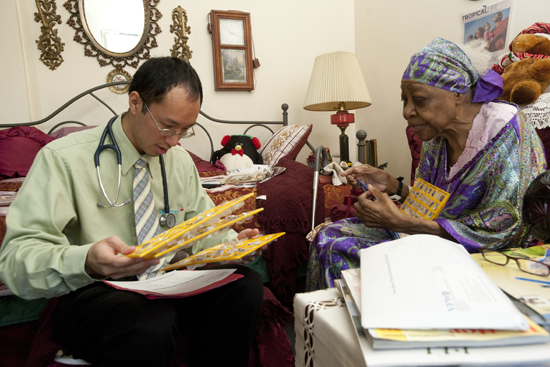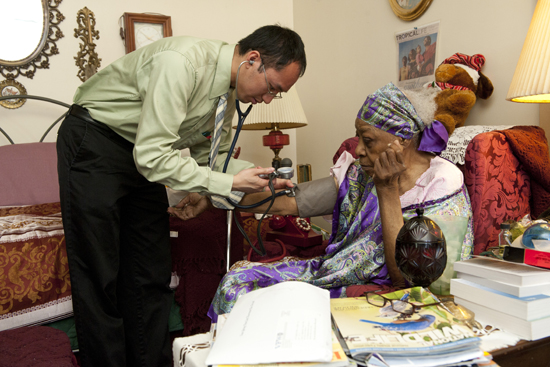House Calls and a Higher Purpose: MED’s Home Care Program teaches how to care for the elderly
 Eugene Lee (CAS’08, MED’12) (left) and Lisa Norton, a School of Medicine clinical assistant professor, on a home care visit to 87-year-old Pauline Harris. Photos by Vernon Doucette
Eugene Lee (CAS’08, MED’12) (left) and Lisa Norton, a School of Medicine clinical assistant professor, on a home care visit to 87-year-old Pauline Harris. Photos by Vernon Doucette
Lisa Norton walks briskly to her first home visit of the day, hardly slowing to update her student about the assortment of health problems afflicting her 87-year-old patient Pauline Harris, who lives in the South End. Norton, a geriatrician and a School of Medicine clinical assistant professor of geriatrics, mentions one last thing before she and Eugene Lee buzz Harris’ apartment: “She’s not horribly compliant with her meds.” Turns out, that’s a big understatement.
Opening the door to her second-floor home, Harris radiates Southern charm as she invites her guests to take a seat in her cluttered living room. She walks slowly past prints of Mary Baker Eddy in the hallway and settles into a red velvet armchair wedged between a futon and an end table. Over the next hour, Norton and Lee will ask questions, draw blood, and take her pulse and blood pressure.
Norton is one of six geriatricians and as many nurses in MED’s Home Care Program caring for approximately 570 patients who find it difficult to leave their homes. The program, the oldest of its kind in the country, has been a part of the University’s curriculum since the 1870s, and its core practices—along with lectures from insurance coverage to end-of-life care—are taught to fourth-year MED students in a monthlong geriatric rotation. It’s one of myriad ways that MED faculty and students venture beyond campus and into the community.
Lee (CAS’08, MED’12) asks about Harris’ breathing, balance, and diet while Norton takes notes on her laptop. She scans the papers, magazines, and knickknacks covering nearly every flat surface and asks Harris where her pills are. The patient gazes around the room and eventually unearths several yellow and blue cards covered in rows of plastic bubbles, each one designed for daily or nightly dosage. They’re all empty, and they’re seven months old. “I think there’s some compliance issues here,” Norton says. “We definitely need to get you new pills.”
The troubling details about Harris’ compliance might have gone unseen in a clinic visit, as would the literature revealing that Harris is a Christian Scientist.
Home visits like this one give Norton and her colleagues a better look into their patients’ lives and help them treat the whole person, not just a collection of ailments. “That’s really important in geriatrics,” she says. “You can lose the forest for the trees.”
“There’s so much more that we can understand about a patient just by doing one home visit,” says Lisa Caruso, a MED assistant professor of geriatrics. Visiting doctors learn how well patients navigate stairs, stock their fridges, and take (or don’t take) their medication.
 Lee checks Harris’ medication cards for dates and dosage levels.
Lee checks Harris’ medication cards for dates and dosage levels.
And educating the next generation of doctors about elder care has never been more important. The American Geriatrics Society counts about 7,100 board-certified geriatricians in the country. That number will have to multiply nearly fivefold to meet the needs of the more than 71 million Americans who will be over 65 by 2030, according to the American Medical Student Association.
The School of Medicine does not track how many graduates go into geriatrics, but it is understood to be one of the less glamorous medical specialties. According to the Medical Group Management Association’s Physician Compensation and Production Survey, geriatricians earned an average salary of $183,523 in 2010—half of the yearly $392,885 earned by dermatologists. And the specialty doesn’t exactly come with the same adrenaline rush as cardiology or emergency medicine.
Labor of love
Doctors at Boston Medical Center, MED’s primary teaching hospital, who pursue geriatrics do so as a labor of love, and they hope to use the Home Care Program to show medical students the field’s quiet appeal. “You have to get them to fall in love with what you do,” says Daniel Oates (CAS’00, MED’00, SPH’05), the Home Care Program’s medical director and a MED assistant professor of geriatrics. And while Oates knows that most students will choose more lucrative or sexy specialties, he and his colleagues hope the experience they’ve gained will inform their future specialties.
Lee, for one, thinks his geriatrics rotation will greatly help his future in primary care. Back at Harris’ home, he and Norton try to solve the medication mystery. Harris tells them that her son, Billy, used to help with her medication, but he no longer lives with her. They analyze the pill packages to determine which is the most recent. (Harris “keeps empties to recycle.”) While Lee calls the pharmacy, the doctor takes a vial of her patient’s blood. Soon Lee has an answer, a discouraging one: Harris’ medication deliveries had been put on hold four months ago, which means she has been taking her medication only sporadically.
 Lee takes Harris’ blood pressure as part of her home exam.
Lee takes Harris’ blood pressure as part of her home exam.
The problems of BMC’s geriatric patients, like Harris, are complex. They are usually in their mid-80s, live below the poverty line, and are eligible for subsidized health insurance. Many are not native English speakers. They often live with multiple chronic conditions—high blood pressure, diabetes, anemia—each treated with a different medication. Knowing how those drugs interact, especially in the elderly, is key to a geriatrician’s job, as is knowing that typical diseases like pneumonia and heart failure may manifest themselves differently than they do in younger patients.
“Elder adults sometimes get marginalized,” says Oates. “They sometimes get forgotten. People don’t know what to do with them.” But he’s familiar with the special requirements of caring for elderly patients, and a lot of it has to do with using a team approach that relies on the help of many specialists.
Oates is also ever mindful of how he communicates with his patients. He knows that 45 percent of the U.S. population reads at or below an eighth-grade level, and that patients who don’t understand a doctor’s message could end up in the hospital, or in severe cases, in a fight for their lives. That’s why he runs a workshop for students on how to avoid medical jargon, especially when talking to elderly patients. Oates typically reviews care plans with his patients and then has them “teach it back to me.” If it’s clear they haven’t understood, he repeats it until he’s sure they do.
But sometimes, as Norton knows well, what’s most important is just listening to patients. Harris, for example, says she feels good. And Lee’s blood pressure and pulse readings a full two days after she took her last pills don’t raise any red flags. Her legs and feet also show no signs of swelling. Maybe, the doctor tells her student, it’s time to take a second look at Harris’ medication list.
“The most important thing,” Norton says, “is not really how the disease is doing, but how the patient is doing.”
And Harris seems to be doing OK. An hour after they arrive, Norton and Lee head out the door for their next appointment. They have several patients to visit and it’s nearly noon. Time to pick up the pace.
This BU Today story was written by Leslie Friday. She can be reached at lfriday@bu.edu
View all posts